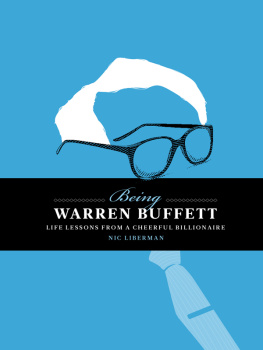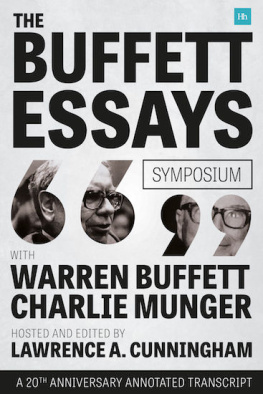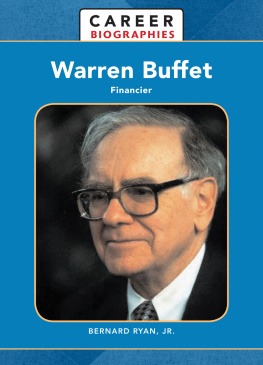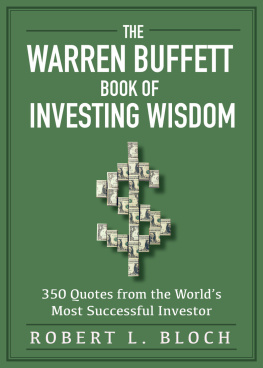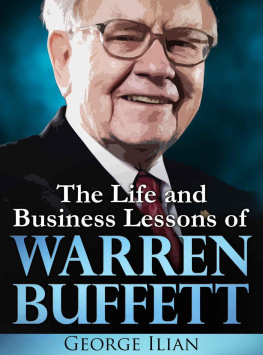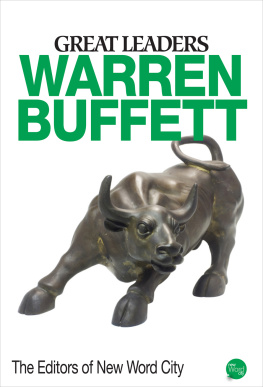Buffett Warren - Security analysis : principles and technique
Here you can read online Buffett Warren - Security analysis : principles and technique full text of the book (entire story) in english for free. Download pdf and epub, get meaning, cover and reviews about this ebook. City: New York, United States, year: 2009, publisher: McGraw-Hill, genre: Romance novel. Description of the work, (preface) as well as reviews are available. Best literature library LitArk.com created for fans of good reading and offers a wide selection of genres:
Romance novel
Science fiction
Adventure
Detective
Science
History
Home and family
Prose
Art
Politics
Computer
Non-fiction
Religion
Business
Children
Humor
Choose a favorite category and find really read worthwhile books. Enjoy immersion in the world of imagination, feel the emotions of the characters or learn something new for yourself, make an fascinating discovery.

- Book:Security analysis : principles and technique
- Author:
- Publisher:McGraw-Hill
- Genre:
- Year:2009
- City:New York, United States
- Rating:3 / 5
- Favourites:Add to favourites
- Your mark:
- 60
- 1
- 2
- 3
- 4
- 5
Security analysis : principles and technique: summary, description and annotation
We offer to read an annotation, description, summary or preface (depends on what the author of the book "Security analysis : principles and technique" wrote himself). If you haven't found the necessary information about the book — write in the comments, we will try to find it.
Security analysis : principles and technique — read online for free the complete book (whole text) full work
Below is the text of the book, divided by pages. System saving the place of the last page read, allows you to conveniently read the book "Security analysis : principles and technique" online for free, without having to search again every time where you left off. Put a bookmark, and you can go to the page where you finished reading at any time.
Font size:
Interval:
Bookmark:
.
Benjamin Graham was a seminal figure on Wall Street and is widely acknowledged to be the father of modern security analysis. The founder of the value school of investing and founder and former president of the Graham-Newman corporation investment fund, Graham taught at Columbia Universitys Graduate School of Business from 1928 through 1957. He popularized the examination of price-to-earnings (P/E) ratios, debt-to-equity ratios, dividend records, book values, and earnings growth, and also wrote the popular investors guide The Intelligent Investor.
David L. Dodd was a colleague of Benjamin Grahams at Columbia University, where he was an assistant professor of finance.
.
I owe much to the coeditors and contributors who found time in their busy lives to share their insights and experiences for the readers of this edition. On behalf of all of them, I would like to acknowledge our authors, Benjamin Graham and David Dodd. Through their writings and legacy, they have touched each of us in important ways; obviously, without them, this collaboration would never have happened. I would also like to thank Warren Buffett for his very personal foreword and, more important, for serving as the living embodiment of Graham and Dodds principles of value investing, sound reasoning, high integrity, and generosity through the avenues of teaching and philanthropy.
In addition, I must acknowledge a debt to Leah Spiro, who had the idea to bring together leading practitioners of value investing to tell us how they apply Graham and Dodds principles today. This collaboration was difficult to orchestrate, and some doubted it could be done. Indeed, the project would have faltered if not for her persistence and leadership. My thanks also goes to the many professionals at McGraw-Hillincluding Philip Ruppel, Herb Schaffner, Laura Friedman, Seth Morris, Lydia Rinaldi, Anthony Landi, Jane Palmieri, and Maureen Harperwho ensured that this would be a work of which we could all be proud.
Seth A. Klarman
Lead Editor
THE SCOPE AND LIMITATIONS OF
SECURITY ANALYSIS. THE CONCEPT
OF INTRINSIC VALUE
.
ANALYSIS CONNOTES the careful study of available facts with the attempt to draw conclusions therefrom based on established principles and sound logic. It is part of the scientific method. But in applying analysis to the field of securities we encounter the serious obstacle that investment is by nature not an exact science. The same is true, however, of law and medicine, for here also both individual skill (art) and chance are important factors in determining success or failure. Nevertheless, in these professions analysis is not only useful but indispensable, so that the same should probably be true in the field of investment and possibly in that of speculation.
In the last three decades the prestige of security analysis in Wall Street has experienced both a brilliant rise and an ignominious falla history related but by no means parallel to the course of stock prices. The advance of security analysis proceeded uninterruptedly until about 1927, covering a long period in which increasing attention was paid on all sides to financial reports and statistical data. But the new era commencing in 1927 involved at bottom the abandonment of the analytical approach; and while emphasis was still seemingly placed on facts and figures, these were manipulated by a sort of pseudo-analysis to support the delusions of the period. The market collapse in October 1929 was no surprise to such analysts as had kept their heads, but the extent of the business collapse which later developed, with its devastating effects on established earning power, again threw their calculations out of gear. Hence the ultimate result was that serious analysis suffered a double discrediting: the firstprior to the crashdue to the persistence of imaginary values, and the secondafter the crashdue to the disappearance of real values.
The experiences of 19271933 were of so extraordinary a character that they scarcely provide a valid criterion for judging the usefulness of security analysis. As to the years since 1933, there is perhaps room for a difference of opinion. In the field of bonds and preferred stocks, we believe that sound principles of selection and rejection have justified themselves quite well. In the common-stock arena the partialities of the market have tended to confound the conservative viewpoint, and conversely many issues appearing cheap under analysis have given a disappointing performance. On the other hand, the analytical approach would have given strong grounds for believing representative stock prices to be too high in early 1937 and too low a year later.
1. DESCRIPTIVE FUNCTION
The functions of security analysis may be described under three headings: descriptive, selective, and critical. In its more obvious form, descriptive analysis consists of marshalling the important facts relating to an issue and presenting them in a coherent, readily intelligible manner. This function is adequately performed for the entire range of marketable corporate securities by the various manuals, the Standard Statistics and Fitch services, and others. A more penetrating type of description seeks to reveal the strong and weak points in the position of an issue, compare its exhibit with that of others of similar character, and appraise the factors which are likely to influence its future performance. Analysis of this kind is applicable to almost every corporate issue, and it may be regarded as an adjunct not only to investment but also to intelligent speculation in that it provides an organized factual basis for the application of judgment.
In its selective function, security analysis goes further and expresses specific judgments of its own. It seeks to determine whether a given issue should be bought, sold, retained, or exchanged for some other. What types of securities or situations lend themselves best to this more positive activity of the analyst, and to what handicaps or limitations is it subject? It may be well to start with a group of examples of analytical judgments, which could later serve as a basis for a more general inquiry.
Examples of Analytical Judgments. In 1928 the public was offered a large issue of 6% noncumulative preferred stock of St. Louis-San Francisco Railway Company priced at 100. The record showed that in no year in the companys history had earnings been equivalent to as much as 1 times the fixed charges and preferred dividends combined. The application of well-established standards of selection to the facts in this case would have led to the rejection of the issue as insufficiently protected.
A contrasting example: In June 1932 it was possible to purchase 5% bonds of Owens-Illinois Glass Company, due 1939, at 70, yielding 11% to maturity. The companys earnings were many times the interest requirementsnot only on the average but even at that time of severe depression. The bond issue was amply covered by current assets alone, and it was followed by common and preferred stock with a very large aggregate market value, taking their lowest quotations. Here, analysis would have led to the recommendation of this issue as a strongly entrenched and attractively priced investment.
Let us take an example from the field of common stocks. In 1922, prior to the boom in aviation securities, Wright Aeronautical Corporation stock was selling on the New York Stock Exchange at only $8, although it was paying a $1 dividend, had for some time been earning over $2 a share, and showed more than $8 per share in cash assets in the treasury. In this case analysis would readily have established that the intrinsic value of the issue was substantially above the market price.
Font size:
Interval:
Bookmark:
Similar books «Security analysis : principles and technique»
Look at similar books to Security analysis : principles and technique. We have selected literature similar in name and meaning in the hope of providing readers with more options to find new, interesting, not yet read works.
Discussion, reviews of the book Security analysis : principles and technique and just readers' own opinions. Leave your comments, write what you think about the work, its meaning or the main characters. Specify what exactly you liked and what you didn't like, and why you think so.


